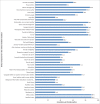Poor consistency in evaluating South African adults with neurogenic dysphagia
- PMID: 28155280
- PMCID: PMC5842977
- DOI: 10.4102/sajcd.v64i1.158
Poor consistency in evaluating South African adults with neurogenic dysphagia
Abstract
Background: Speech-language therapists are specifically trained in clinically evaluating swallowing in adults with acute stroke. Incidence of dysphagia following acute stroke is high in South Africa, and health implications can be fatal, making optimal management of this patient population crucial. However, despite training and guidelines for best practice in clinically evaluating swallowing in adults with acute stroke, there are low levels of consistency in these practice patterns.
Objective: The aim was to explore the clinical practice activities of speech-language therapists in the clinical evaluation of swallowing in adults with acute stroke. Practice activities reviewed included the use and consistency of clinical components and resources utilised. Clinical components were the individual elements evaluated in the clinical evaluation of swallowing (e.g. lip seal, vocal quality, etc.)Methods: The questionnaire used in the study was replicated and adapted from a study increasing content- and criterion-related validity. A narrative literature review determined what practice patterns existed in the clinical evaluation of swallowing in adults. A pilot study was conducted to increase validity and reliability. Purposive sampling was used by sending a self-administered, electronic questionnaire to members of the South African Speech-Language-Hearing Association. Thirty-eight participants took part in the study. Descriptive statistics were used to analyse the data and the small qualitative component was subjected to textual analysis.
Results: There was high frequency of use of 41% of the clinical components in more than 90% of participants (n = 38). Less than 50% of participants frequently assessed sensory function and gag reflex and used pulse oximetry, cervical auscultation and indirect laryngoscopy. Approximately a third of participants showed high (30.8%), moderate (35.9%) and poor (33.3%) consistency of practice each. Nurses, food and liquids and medical consumables were used usually and always by more than 90% of participants.
Conclusion: Infrequent use of clinical components and high variability in clinical practice among speech-language therapists calls for uniform curricula in the clinical evaluation of swallowing at South African universities and for continued professional development post-graduation. Different contexts and patient symptoms contribute towards varied practice; however, there is still a need to improve consistency of practice for quality health care delivery. A research-based policy for the clinical swallowing evaluation for a resource-limited context is also needed.
Conflict of interest statement
The authors declare that they have no financial or personal relationships which may have inappropriately influenced them in writing this article.
Figures



References
-
- Albini R.M.N., Soares V.M.N., Wolf A.E., & Goncalves C.G.D.O (2013). Knowledge of nursing professionals about the care to dysphagic patients in intensive care units. Revista CEFAC, 15(6), 1512–1524. http://dx.doi.org/10.1590/S1516-18462013005000047 - DOI
-
- American Speech-Language-Hearing Association (2004). Preferred practice patterns for the profession of speech-language pathology. [Preferred practice patterns]. Retrieved June 29, 2014, from http://www.asha.org/policya - PubMed
-
- American Speech-Language-Hearing Association (2005). Evidence-based practice in communication disorders. [Position statement]. Retrieved from http://www.asha.org/policy/PS2005-00221.htm
-
- Babbie E., & Mouton J (2001). The practice of social research: South African edition. Cape Town, South Africa: Oxford University Press.
-
- Balzer K.M. (2000). Drug-induced dysphagia. International Journal of MS Care, 2(1), 6–7. http://dx.doi.org/10.7224/1537-2073-2.1.40 - DOI
Publication types
MeSH terms
LinkOut - more resources
Full Text Sources
Other Literature Sources
Medical
